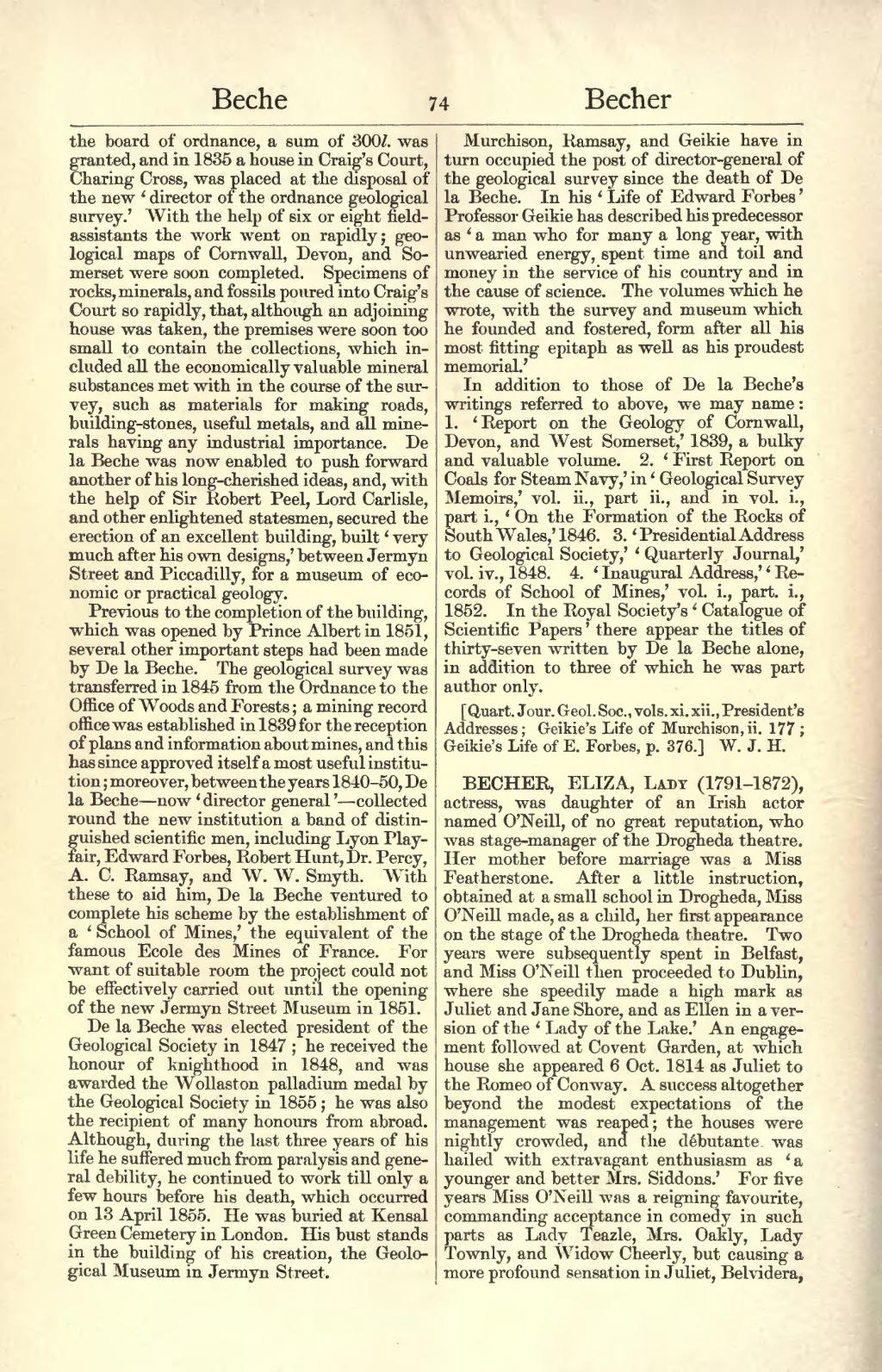the board of ordnance, a sum of 300l. was granted, and in 1835 a house in Craig's Court, Charing Cross, was placed at the disposal of the new 'director of the ordnance geological survey.' With the help of six or eight field-assistants the work went on rapidly; geological maps of Cornwall, Devon, and Somerset were soon completed. Specimens of rocks, minerals, and fossils poured into Craig's Court so rapidly, that, although an adjoining house was taken, the premises were soon too small to contain the collections, which included all the economically valuable mineral substances met with in the course of the survey, such as materials for making roads, building-stones, useful metals, and all minerals having any industrial importance. De la Beche was now enabled to push forward another of his long-cherished ideas, and, with the help of Sir Robert Peel, Lord Carlisle, and other enlightened statesmen, secured the erection of an excellent building, built 'very much after his own designs,' between Jermyn Street and Piccadilly, for a museum of economic or practical geology.
Previous to the completion of the building, which was opened by Prince Albert in 1851, several other important steps had been made by De la Beche. The geological survey was transferred in 1845 from the Ordnance to the Office of Woods and Forests; a mining record office was established in 1839 for the reception of plans and information about mines, and this has since approved itself a most useful institution; moreover, between the years 1840-50, De la Beche — now 'director general' — collected round the new institution a band of distinguished scientific men, including Lyon Playfair, Edward Forbes, Robert Hunt, Dr. Percy, A. C. Ramsay, and W. W. Smyth. With these to aid him, De la Beche ventured to complete his scheme by the establishment of a 'School of Mines,' the equivalent of the famous Ecole des Mines of France. For want of suitable room the project could not be effectively carried out until the opening of the new Jermyn Street Museum in 1851.
De la Beche was elected president of the Geological Society in 1847; he received the honour of knighthood in 1848, and was awarded the Wollaston palladium medal by the Geological Society in 1855; he was also the recipient of many honours from abroad. Although, during the last three years of his life he suffered much from paralysis and general debility, he continued to work till only a few hours before his death, which occurred on 13 April 1855. He was buried at Kensal Green Cemetery in London. His bust stands in the building of his creation, the Geological Museum in Jermyn Street.
Murchison, Ramsay, and Geikie have in turn occupied the post of director-general of the geological survey since the death of De la Beche. In his 'Life of Edward Forbes' Professor Geikie has described his predecessor as 'a man who for many a long year, with unwearied energy, spent time and toil and money in the service of his country and in the cause of science. The volumes which he wrote, with the survey and museum which he founded and fostered, form after all his most fitting epitaph as well as his proudest memorial.'
In addition to those of De la Beche's writings referred to above, we may name: 1. 'Report on the Geology of Cornwall, Devon, and West Somerset,' 1839, a bulky and valuable volume. 2. 'First Report on Coals for Steam Navy,' in 'Geological Survey Memoirs,' vol. ii., part ii., and in vol i., part i., 'On the Formation of the Rocks of South Wales,' 1846. 3. 'Presidential Address to Geological Society,' 'Quarterly Journal,' vol. iv., 1848. 4. 'Inaugural Address,' 'Records of School of Mines,' vol i. part. i., 1852. In the Royal Society's 'Catalogue of Scientific Papers' there appear the titles of thirty-seven written by De la Beche alone, in addition to three of which he was part author only.
[Quart. Jour. Geol. Soc, vols. xi. xii., President's Addresses; Geikie's Life of Murchison, ii. 177; Geikie's Life of E. Forbes, p. 376.]
BECHER, ELIZA, Lady (1791–1872),
actress, was daughter of an Irish actor
named O'Neill, of no great reputation, who
was stage-manager of the Drogheda theatre.
Her mother before marriage was a Miss
Featherstone. After a little instruction,
obtained at a small school in Drogheda, Miss
O'Neill made, as a child, her first appearance
on the stage of the Drogheda theatre. Two
years were subsequently spent in Belfast,
and Miss O'Neill then proceeded to Dublin,
where she speedily made a high mark as
Juliet and Jane Shore, and as Ellen in a version of the 'Lady of the Lake.' An engagement followed at Covent Garden, at which
house she appeared 6 Oct. 1814 as Juliet to
the Romeo of Conway. A success altogether
beyond the modest expectations of the
management was reaped; the houses were
nightly crowded, and the débutante was
hailed with extravagant enthusiasm as 'a
younger and better Mrs. Siddons.' For five
years Miss O'Neill was a reigning favourite,
commanding acceptance in comedy in such
parts as Lady Teazle, Mrs. Oakly, Lady
Townly, and Widow Cheerly, but causing a
more profound sensation in Juliet, Belvidera,
